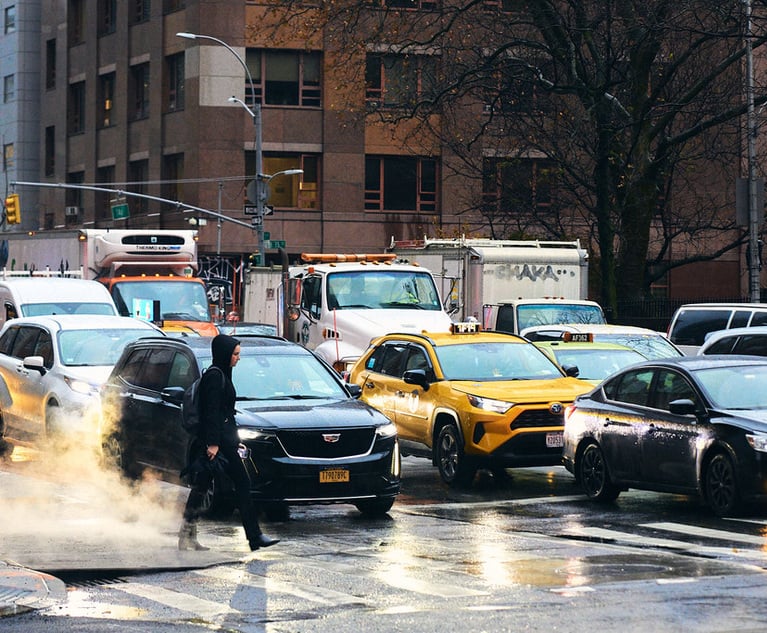To Foresee or Not to Foresee?
That is the question for determining liability for criminal acts by third parties.
October 19, 2018 at 12:00 PM
9 minute read

It has long been the law in New Jersey that commercial property owners and business operators have a duty to ensure their premises are reasonably safe for patrons. This often includes the duty to protect customers from criminal acts committed by third parties while on the premises. And, the failure to satisfy that a duty can result in liability for the injuries caused by those criminal acts.
While an owner/operator's duty to protect from third-party criminal acts is not absolute, there is unfortunately no bright-line test to confidently predict when the duty will be found to exist. Instead, when a lawsuit is filed, it is left to the judge to decide whether the duty existed for the particular criminal act.
The judge's decision has historically been driven by four factors: 1) the owner/operator's ability to reasonably foresee the criminal act; 2) the public's interest in imposing such a duty; 3) the fairness of imposing such a duty; and 4) the relationship between the parties. That said, the factor that has been given the greatest amount of weight over the years has been the first, i.e., the reasonable foreseeability of the criminal act.
But what is actually meant by the “ability to reasonably foresee the criminal act”? It is a concept that has evolved over the years. And, that evolution is worth exploring in order to inform owners/operators how to best avoid potential liability in the future.
In the early 1980's, the New Jersey Supreme Court reached two decisions in which the foreseeability factor supported finding a duty by the owner/operator. In each of those opinions, the court relied upon the history of similar criminal acts occurring on the subject premises. See Trentacost v. Brussel, 82 N.J. 214 (1980) (affirming judgment against an apartment complex owner/operator for the robbery of a tenant inside a stairwell, given an attempted break-in two months earlier, complaints of unauthorized persons in the hallways, and the failure to install a lock on the building's front entrance); Butler v. Acme Markets, 89 N.J. 270 (1982) (reinstating a verdict against a supermarket owner for the robbery of a customer in the parking lot, given the occurrence of seven muggings on the premises during the prior five years—five of which occurred in the four months immediately prior to the subject attack).
Nearly 20 years later, the Supreme Court would clarify that the standard for determining whether a criminal act was reasonably foreseeable did not necessarily require a history of similar criminal acts. Instead, the court would adopt a “totality of the circumstances” standard.
In Clohesy v. Food Circus Supermarkets, 149 N.J. 496 (1997), a supermarket customer was abducted from the store's parking lot. In finding the store owner should have foreseen at least an assault in the parking lot, the Supreme Court noted that 60 criminal incidents had occurred on or near the premises during the preceding two-and-a-half years, even though there had been no prior abductions. The court also noted that the store had been providing no passive or active security for the parking lot and that the abduction had occurred in a section of the lot that was not visible from within the store. Lastly, the court noted that a gas station and liquor store were adjacent to the parking lot, which served as gathering places for loiterers to drink and “hang around.” Given the totality of the circumstances, the court found it was reasonably foreseeable that a customer would eventually be assaulted in the parking lot, and the owner therefore owed a duty to provide some measure of security there.
That same year, the Supreme Court addressed a similar type of case, finding that foreseeability of harm is not always the dispositive factor for determining the existence of a duty, particularly when the criminal act occurs off-premises.
In Kuzmicz v. Ivy Hill Apartments, 147 N.J. 510 (1997), the court held that an apartment complex owner did not owe a duty to protect a tenant who was attacked while cutting across an adjacent vacant lot, even though the owner knew the lot was the scene of occasional drug activity and other criminal conduct. In fact, the owner had previously complained about the lot owner's failure to maintain the lot, and had even erected an eight-foot-high chain link fence to separate its property from the lot. Prior to the attack, the owner knew someone had cut openings in the fence, and the owner had even mended the fence several times. The owner also knew that tenants and employees of the complex routinely walked across the lot as a shortcut to a shopping plaza.
Despite the apartment complex owner's foreseeability of harm to tenants and employees using the vacant lot as a shortcut, the Supreme Court in Kuzmicz refused to find the owner owed a duty to protect such individuals from acts taking place on lot—over which the owner had no control and from which the owner derived no economic benefit. Interestingly, the court noted that as a matter of public policy, imposing such a duty would provide a disincentive to owning rental property in urban areas.
The next year, however, the Appellate Division reached the opposite ruling in a case with similar facts. In Roe v. New Jersey Transit Rail Operations, 317 N.J. Super. 72 (App. Div. 1998), a girl was assaulted while walking from her home to a swimming pool at a public park—a route that crossed into property where a subway station operated. The station's operator had erected a fence along the property line, but the fence had a gate, which was known to be used by pedestrians as shortcut to the park. That shortcut required pedestrians to cross through a section of the park known to be dangerous due to its seclusion and inadequate lighting. Significantly, when the gate eventually broke, the station's operator bolted the gate open, instead of closed.
The Appellate Division found that by bolting the gate open, the station's operator arguably created a dangerous condition with a reasonably foreseeable risk that pedestrians would use the gate, thereby leading to the type of injury that eventually occurred. The Appellate Division relied upon this fact to distinguish the case from Kuzmicz, where the apartment complex owner had previously taken steps to prevent the use of a shortcut by repairing cuts in its border fence. The Appellate Division also noted the subway station owner potentially derived an incidental benefit from the gate being bolted open, since it provided or encouraged additional access to the subway station.
The Appellate Division has continued to rely primarily upon the foreseeability factor to determine whether a duty to protect from a criminal act exists, with consistent results. In the early 2000's, the Appellate Division addressed cases in which foreseeability created a duty to protect. See Zepf v. Hilton Hotel & Casino, 346 N.J. Super. 6 (App. Div. 2001) (finding foreseeable that a casino employee would be attacked while walking to her car on an adjacent street, given 1) the nature of the casino business, 2) the history of criminal activities in the area, 3) that the casino's security system improperly excluded this particular street, and 4) that not all employees used the complimentary shuttle bus and secure parking lot); Kuehn v. Pub Zone, 364 N.J. Super. 301 (App. Div. 2003) (finding foreseeable that members of a motorcycle gang would attack a tavern patron in the men's room for no known reason, based on the tavern owner's past experiences and information provided to him by others).
Inversely, the Appellate Division has found the lack of foreseeability to equate to a lack of a duty to protect. See Sanchez v. Independent Bus Co., 358 N.J. Super. 74 (App. Div. 2003) (finding unforeseeable that a bus passenger would shoot a handgun multiple times in the rear of the bus, given the passenger had followed the bus driver's instructions and had not acted in a threatening manner, and that the incident leading up to the shooting occurred within a timeframe of about 30seconds).
More recently, the Appellate Division has continued to find the lack of foreseeability to equate to a lack of a duty to protect. See Higgins v. Holiday Inn & Conf. Ctr., 2017 N.J. Super. Unpub. LEXIS 857 (App. Div. 04/04/17) (finding unforeseeable the shooting by a masked gunman in a parking lot of a hotel where a weekly event was hosted by a disc jockey, given the lack of any criminal activity during the 19 prior times the weekly event was held and the lack of shootings at the hotel during the 10 years prior, and despite there being some reported crimes on the premises during the two years prior).
What can commercial property owners and business operators in New Jersey take away from these cases? Obviously, it should be anticipated that the reasonable foreseeability of a criminal act committed by a third party on the premises will be the biggest factor to determining whether a duty to protect will be found to have existed. The Supreme Court has made clear that a history of similar prior criminal acts on the premises is not necessary for establishing reasonable foreseeability. Instead, the totality of the circumstances will be considered, including the history of other crimes occurring on the premises and the history of similar crimes occurring nearby. Moreover, when the criminal act occurs off-site, it can be expected that foreseeability will not necessarily be the dispositive factor to determining whether a duty to protect existed, particularly if there was no economic benefit being conferred. Lastly, peace of mind can be had knowing that the Appellate Division has more recently been willing to hold no duty to protect for what appears to have been random acts of violence.
Adam Fogarty is an associate with Marshall Dennehey Warner Coleman & Goggin in Mount Laurel. He is a member of the Casualty Department where his practice includes matters involving premises liability.
This content has been archived. It is available through our partners, LexisNexis® and Bloomberg Law.
To view this content, please continue to their sites.
Not a Lexis Subscriber?
Subscribe Now
Not a Bloomberg Law Subscriber?
Subscribe Now
NOT FOR REPRINT
© 2025 ALM Global, LLC, All Rights Reserved. Request academic re-use from www.copyright.com. All other uses, submit a request to [email protected]. For more information visit Asset & Logo Licensing.
You Might Like
View All
Send Us Your New Partners for the NJ Law Journal's New Partners Yearbook
1 minute read
New Methods for Clients and Families to Have Their Estate and Legacy Planning Complete
5 minute read
Tensions Run High at Final Hearing Before Manhattan Congestion Pricing Takes Effect
4 minute readTrending Stories
- 1State Budget Proposal Includes More Money for Courts—for Now
- 2$5 Million Settlement Reached With Stone Academy
- 3$15K Family Vacation Turned 'Colossal Nightmare': Lawsuit Filed Against Vail Ski Resorts
- 4Prepare Your Entries! The California Legal Awards Have a New, February Deadline
- 5DOJ Files Antitrust Suit to Block Amex GBT's Acquisition of Competitor
Who Got The Work
Michael G. Bongiorno, Andrew Scott Dulberg and Elizabeth E. Driscoll from Wilmer Cutler Pickering Hale and Dorr have stepped in to represent Symbotic Inc., an A.I.-enabled technology platform that focuses on increasing supply chain efficiency, and other defendants in a pending shareholder derivative lawsuit. The case, filed Oct. 2 in Massachusetts District Court by the Brown Law Firm on behalf of Stephen Austen, accuses certain officers and directors of misleading investors in regard to Symbotic's potential for margin growth by failing to disclose that the company was not equipped to timely deploy its systems or manage expenses through project delays. The case, assigned to U.S. District Judge Nathaniel M. Gorton, is 1:24-cv-12522, Austen v. Cohen et al.
Who Got The Work
Edmund Polubinski and Marie Killmond of Davis Polk & Wardwell have entered appearances for data platform software development company MongoDB and other defendants in a pending shareholder derivative lawsuit. The action, filed Oct. 7 in New York Southern District Court by the Brown Law Firm, accuses the company's directors and/or officers of falsely expressing confidence in the company’s restructuring of its sales incentive plan and downplaying the severity of decreases in its upfront commitments. The case is 1:24-cv-07594, Roy v. Ittycheria et al.
Who Got The Work
Amy O. Bruchs and Kurt F. Ellison of Michael Best & Friedrich have entered appearances for Epic Systems Corp. in a pending employment discrimination lawsuit. The suit was filed Sept. 7 in Wisconsin Western District Court by Levine Eisberner LLC and Siri & Glimstad on behalf of a project manager who claims that he was wrongfully terminated after applying for a religious exemption to the defendant's COVID-19 vaccine mandate. The case, assigned to U.S. Magistrate Judge Anita Marie Boor, is 3:24-cv-00630, Secker, Nathan v. Epic Systems Corporation.
Who Got The Work
David X. Sullivan, Thomas J. Finn and Gregory A. Hall from McCarter & English have entered appearances for Sunrun Installation Services in a pending civil rights lawsuit. The complaint was filed Sept. 4 in Connecticut District Court by attorney Robert M. Berke on behalf of former employee George Edward Steins, who was arrested and charged with employing an unregistered home improvement salesperson. The complaint alleges that had Sunrun informed the Connecticut Department of Consumer Protection that the plaintiff's employment had ended in 2017 and that he no longer held Sunrun's home improvement contractor license, he would not have been hit with charges, which were dismissed in May 2024. The case, assigned to U.S. District Judge Jeffrey A. Meyer, is 3:24-cv-01423, Steins v. Sunrun, Inc. et al.
Who Got The Work
Greenberg Traurig shareholder Joshua L. Raskin has entered an appearance for boohoo.com UK Ltd. in a pending patent infringement lawsuit. The suit, filed Sept. 3 in Texas Eastern District Court by Rozier Hardt McDonough on behalf of Alto Dynamics, asserts five patents related to an online shopping platform. The case, assigned to U.S. District Judge Rodney Gilstrap, is 2:24-cv-00719, Alto Dynamics, LLC v. boohoo.com UK Limited.
Featured Firms
Law Offices of Gary Martin Hays & Associates, P.C.
(470) 294-1674
Law Offices of Mark E. Salomone
(857) 444-6468
Smith & Hassler
(713) 739-1250







